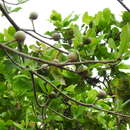en
names in breadcrumbs


Genipa americana (/ˈdʒɛnɪpə/) is a species of trees in the family Rubiaceae. It is native to the tropical forests of North and South America, as well as the Caribbean.
Genipa americana trees are up to 30 m tall and up to 60 cm dbh.[2][3][4] Their bark is smooth with little fissures.[4] The leaves are opposite, obovate, or obovate oblong, 10–35 cm long, 6–13 cm wide, and glossy dark green, with entire margin, acute or acuminate apex, and attenuated base.[2][5][3] The inflorescences are cymes up to 10 cm long.[2] The flowers are white to yellowish, slightly fragrant, calyx bell-shaped, corolla at 2–4.5 cm long, trumpet-shaped, and five- or six-lobed.[2][5][3] The five short stamens are inserted on top of the corolla tube.[5] The fruit is a thick-skinned edible greyish berry 10–12 cm long, 5–9 cm in diameter.[2][5]
Genipa americana is native to the tropical forests of the Americas, from tropical Florida south to Argentina.[2][6][7] It is present from sea level up to 1200 m of elevation,[4] although some argue the original native range as being northern South America.[8]
In English, the tree is known as the genip tree /ˈdʒɛnɪp/ and the fruit as genipap /ˈdʒɛnɪpæp/.[9]
Colombia: jagua, caruto, huito;[4][6] Brazil: jenipapo, formerly genipapo;[4] Costa Rica: guaitil, tapaculo;[4] Nicaragua: tapaculo, yigualtí;[4] Mexico: shagua, xagua, maluco;[4][10] Perú: huito, vito, jagua;[6] Argentina: ñandipá;[6] Puerto Rico: jagua; Bolivia: bí[11]
Its name has been reconstructed as we'e (*weʔe) in Proto-Tucanoan.[12]
The following compounds have been isolated from G. americana: genipic acid,[10] genipinic acid,[10] genipin[13] (all three from the fruit) and geniposidic acid (leaves).[10]
The unripe fruit of G. americana yields a liquid used as a dye for tattoos, skin painting and insect repellent.[7]
This species is also cultivated for its edible fruits, which are eaten in preserves or made into drinks, jelly, or ice cream.[7]
The wood is reported to be resistant, strong, and easily worked; it is used in the making of utensils and in construction and carpentry.[3][4]
Genipa americana (/ˈdʒɛnɪpə/) is a species of trees in the family Rubiaceae. It is native to the tropical forests of North and South America, as well as the Caribbean.